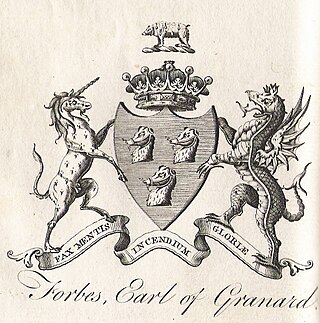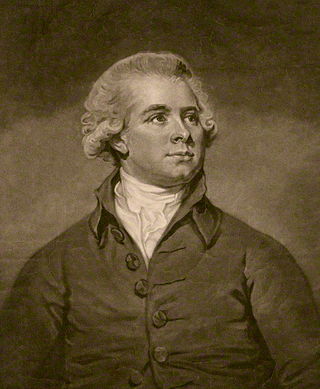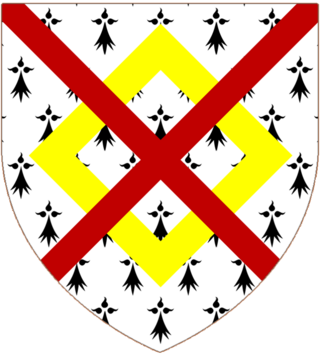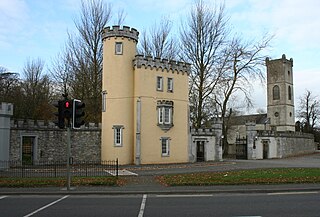
Earl of Lucan is a title which has been created twice in the Peerage of Ireland for related families.

Marquess of Ely, of the County of Wexford, is a title in the Peerage of Ireland. It was created in 1800 for Charles Loftus, 1st Earl of Ely. He was born Charles Tottenham, the son of Sir John Tottenham, 1st Baronet, who had been created a baronet, of Tottenham Green in the County of Wexford, in the Baronetage of Ireland in 1780, by Elizabeth, daughter of Nicholas Loftus, 1st Viscount Loftus, sister and heiress of Henry Loftus, 1st Earl of Ely. In 1783 he succeeded to the Loftus estates on the death of his maternal uncle the Earl of Ely and assumed the same year by Royal licence the surname of Loftus in lieu of his patronymic. In 1785 he was raised to the Peerage of Ireland as Baron Loftus, of Loftus Hall in the County of Wexford. It was sold by the family in 1917 and is today owned by the Quigley family.
Earl of Meath is a title in the Peerage of Ireland created in 1627 and held by the head of the Brabazon family. This family descends from Sir Edward Brabazon, who represented County Wicklow in the Irish House of Commons and served as High Sheriff of Staffordshire in 1606. In 1616 he was raised to the Peerage of Ireland as Baron Ardee. He was succeeded by his eldest son, the second Baron. In 1627 he was created Earl of Meath in the Peerage of Ireland, with remainder to his younger brother the Hon. Sir Anthony Brabazon. Lord Meath was succeeded by his son, the second Earl. His grandson, the fourth Earl, served as Lord-Lieutenant of Dublin and of Kildare. His wife Dorothy Stopford, daughter of James Stopford and Mary Forth, was a close friend of Jonathan Swift. He died childless and was succeeded by his younger brother, the fifth Earl. He was also Lord-Lieutenant of Dublin. Lord Meath married the Hon. Juliana, daughter of Patrick Chaworth, 3rd and last Viscount Chaworth.

Earl of Granard is a title in the Peerage of Ireland. It was created in 1684 for Arthur Forbes, 1st Viscount Granard. He was a lieutenant-general in the army and served as Marshal of the Army in Ireland after the Restoration and was later Lord Justice of Ireland. He had already succeeded his father as second Baronet of Castle Forbes and been created Baron Clanehugh and Viscount Granard in 1675, also in the Peerage of Ireland. The Baronetcy, of Castle Forbes in county Longford, was created in the Baronetage of Nova Scotia on 29 September 1628 for his father, Arthur Forbes.

Earl of Kingston is a title in the Peerage of Ireland. It was created in 1768 for Edward King, 1st Viscount Kingston. The Earl holds the subsidiary titles Baron Kingston, of Rockingham in the County of Roscommon, Viscount Kingston, of Kingsborough in the County of Sligo, Baron Erris, of Boyle in the County of Roscommon, and Viscount Lorton, of Boyle in the County of Roscommon, also in the Peerage of Ireland. He is also a baronet in the Baronetage of Ireland. Between 1821 and 1869 the earls also held the title Baron Kingston, of Mitchelstown in the County of Cork, in the Peerage of the United Kingdom.

Earl of Limerick is a title that has been created twice in the Peerage of Ireland, associated first with the Dongan family, then with the Pery family.

Earl of Clanwilliam is a title in the Peerage of Ireland. It was created in 1776 for John Meade, 1st Viscount Clanwilliam. The Meade family descends from Sir John Meade, who represented Dublin University and County Tipperary in the Irish House of Commons and served as Attorney-General to James, Duke of York. In 1703, he was created a Baronet, of Ballintubber in the County of Cork, in the Baronetage of Ireland. His eldest son, Pierce, the second Baronet, died unmarried at an early age and was succeeded by his younger brother Richard, the third Baronet. Richard represented Kinsale in the Irish Parliament.

Viscount de Vesci, of Abbeyleix in the Queen's County, now called County Laois, is a title in the Peerage of Ireland. It was created in 1776 for Thomas Vesey, 2nd Baron Knapton and 3rd Baronet. The title Baron Knapton was created in the Peerage of Ireland in 1750 for the first Viscount's father, John Vesey, 2nd Baronet, who had earlier represented Newtownards in the Irish House of Commons. The baronetcy, of Abbeyleix in the Queen's County, was created in the Baronetage of Ireland on 28 September 1698 for the first Baron's father, Reverend Thomas Vesey, Bishop of Killaloe (1713–1714) and Bishop of Ossory (1714–1730).
Viscount Hawarden is a title in the Peerage of Ireland.

Baron Henniker, of Stratford-upon-Slaney in the County of Wicklow, is a title in the Peerage of Ireland. It was created in 1800 for Sir John Henniker, 2nd Baronet, who had previously represented Sudbury and Dover in the House of Commons. His son, the second Baron, also sat as a Member of Parliament. In 1792 he assumed by Royal licence the additional surname of Major. He was childless and was succeeded by his nephew, the third Baron. He assumed the additional surname of Major by Royal licence in 1822. His son, the fourth Baron, represented Suffolk East in Parliament. In 1866 he was created Baron Hartismere, of Hartismere in the County of Suffolk, in the Peerage of the United Kingdom. This title gave him and his descendants an automatic seat in the House of Lords. He was succeeded by his son, the fifth Baron. He also sat as Member of Parliament for Suffolk East and later held minor office in the Conservative administrations of Benjamin Disraeli and Lord Salisbury. His grandson, the eighth Baron, was a prominent diplomat and notably served as British Ambassador to Jordan and to Denmark. As of 2014 the titles are held by the latter's son, the ninth Baron, who succeeded in 2004.

Baron Newborough is a title that has been created twice in the Peerage of Ireland. Both titles are extant. The first creation came in 1716 in favour of George Cholmondeley, later 2nd Earl of Cholmondeley. See Marquess of Cholmondeley for further history of this creation. The second creation came in 1776 in favour of Sir Thomas Wynn, 3rd Baronet. He represented Caernarvonshire, St Ives and Beaumaris in the House of Commons and also served as Lord Lieutenant of Caernarvonshire. His son, the second Baron, represented Caernarvonshire in Parliament. He died unmarried and was succeeded by his younger brother, the third Baron. He served as High Sheriff of Anglesey in 1847. On his death the titles passed to his grandson, the fourth Baron. He died as a result of an illness contracted on active service during the First World War and was succeeded by his younger brother, the fifth Baron. When he died in 1957 the titles were inherited by his first cousin, the sixth Baron. He was the son of the Hon. Charles Henry Wynn, third son of the third Baron. He was succeeded in 1965 by his eldest son as the seventh Baron. As of 2022 the titles are held by the seventh Baron's son, the eighth Baron, who succeeded his father in 1998.

Viscount Midleton, of Midleton in the County of Cork, is a title in the Peerage of Ireland. It was created in 1717 for Alan Brodrick, 1st Baron Brodrick, the Lord Chancellor of Ireland and former Speaker of the Irish House of Commons. He was created Baron Brodrick, of Midleton in the County of Cork, in 1715 in the same peerage. His grandson, the third Viscount, co-represented Ashburton then New Shoreham in the British House of Commons. His son, the fourth Viscount, sat similarly for Whitchurch for 22 years. In 1796 he was created Baron Brodrick, of Peper Harrow in the County of Surrey, in the Peerage of Great Britain, with a special remainder to the heirs male of his father, the third Viscount. On the death of his son, the fifth Viscount, this line of the family failed.

Richard Le Poer Trench, 2nd Earl of Clancarty, 1st Marquess of Heusden, styled The Honourable from 1797 to 1803 and then Viscount Dunlo to 1805, was an Anglo-Irish peer, a nobleman in the Dutch nobility, and a diplomat. He was an Irish, and later British, Member of Parliament and a supporter of Pitt. Additionally he was appointed Postmaster General of Ireland, and later, of the United Kingdom.

John David FitzGerald, Baron FitzGerald, PC, PC (Ire) was an Irish judge and Liberal politician.

Earl of Carrick, in the barony of Iffa and Offa East, County Tipperary, is a title in the Peerage of Ireland.

There have been seventeen baronetcies for persons with the surname Stewart, ten in the Baronetage of Nova Scotia, one in the Baronetage of Ireland and six in the Baronetage of the United Kingdom. See also Steuart baronets, Henderson-Stewart baronets, MacTaggart-Stewart baronets and Stewart-Clark baronets.
The High Sheriff of Queen's County was the British Crown's judicial representative in Queen's County, Ireland, Ireland from the 16th century until 1922, when the office was abolished in the new Free State and replaced by the office of Offaly County Sheriff. The sheriff had judicial, electoral, ceremonial and administrative functions and executed High Court Writs. In 1908, an Order in Council made the Lord-Lieutenant the Sovereign's prime representative in a county and reduced the High Sheriff's precedence. However, the sheriff retained his responsibilities for the preservation of law and order in the county. The usual procedure for appointing the sheriff from 1660 onwards was that three persons were nominated at the beginning of each year from the county and the Lord Lieutenant then appointed his choice as High Sheriff for the remainder of the year. Often the other nominees were appointed as under-sheriffs. Sometimes a sheriff did not fulfil his entire term through death or other event and another sheriff was then appointed for the remainder of the year. The dates given hereunder are the dates of appointment. All addresses are in Queen's County unless stated otherwise.
John Otway Cuffe, 2nd Earl of Desart was an Anglo-Irish politician and peer.

Rt. Hon. Arthur Moore was an Irish lawyer, judge, and politician.
Sir John Tydd, 1st Baronet, of Lamberton, Queen's County was an Irish politician, landowner and baronet.